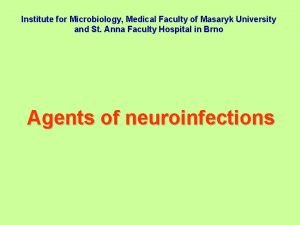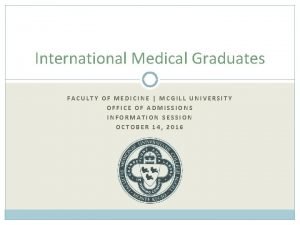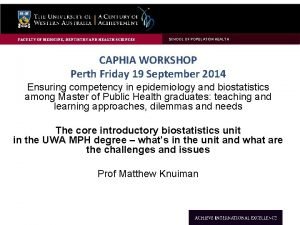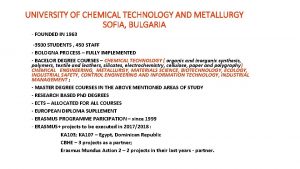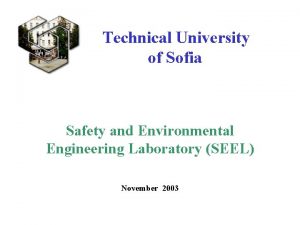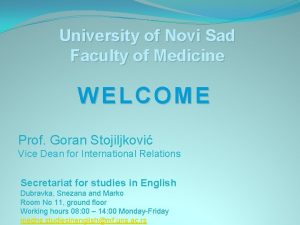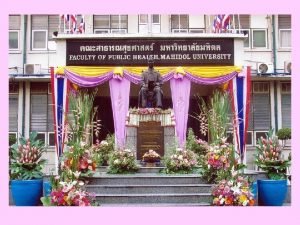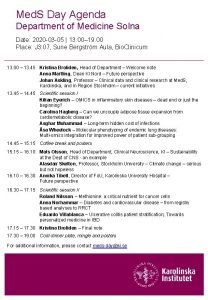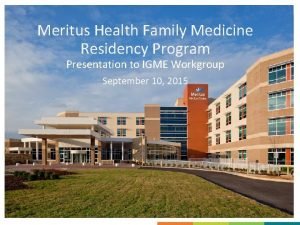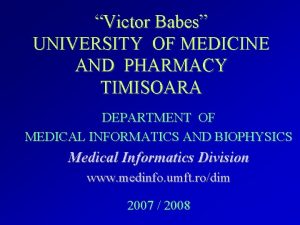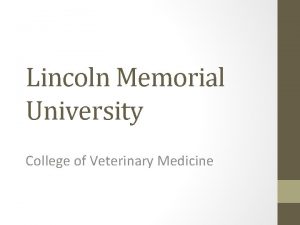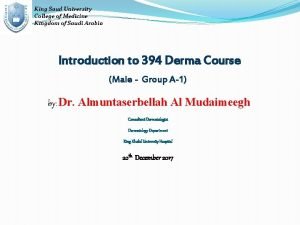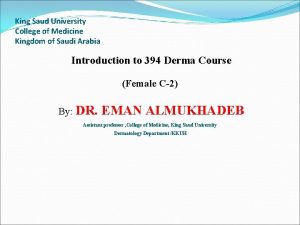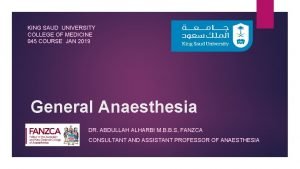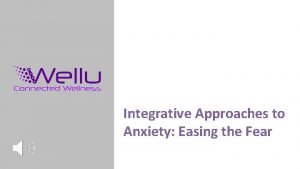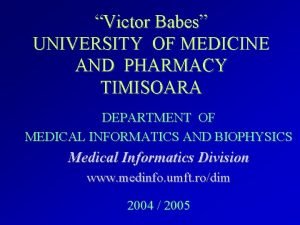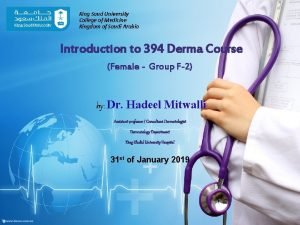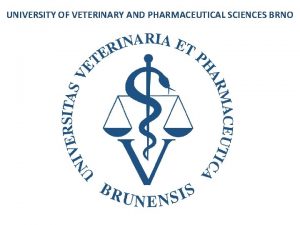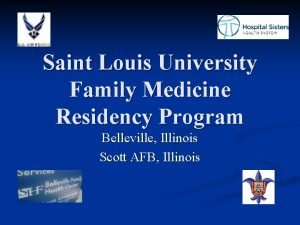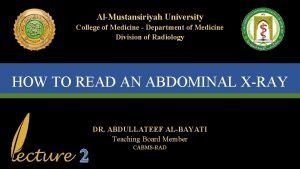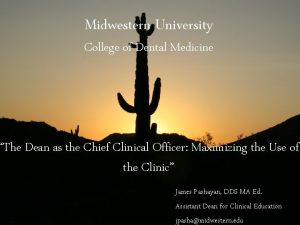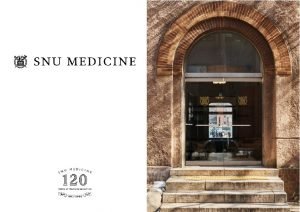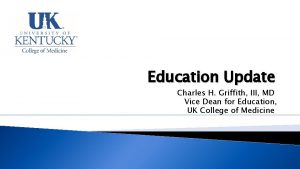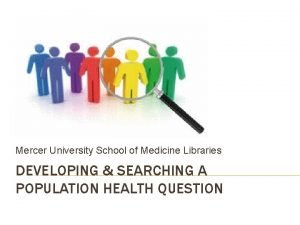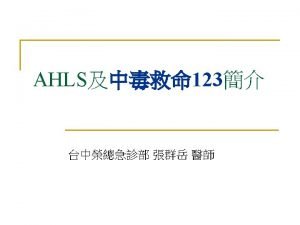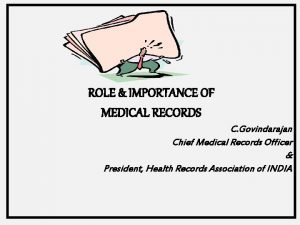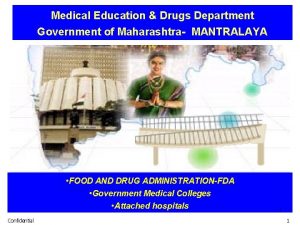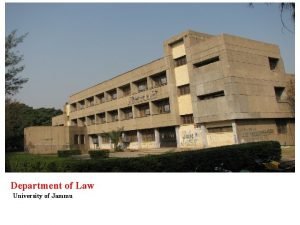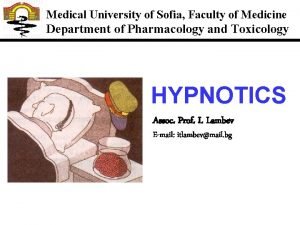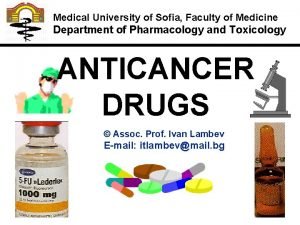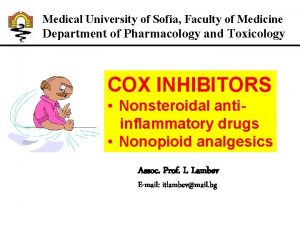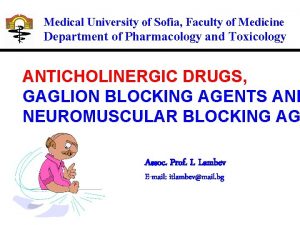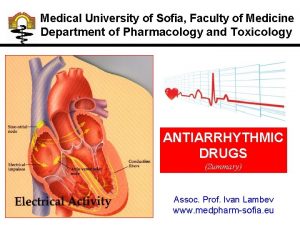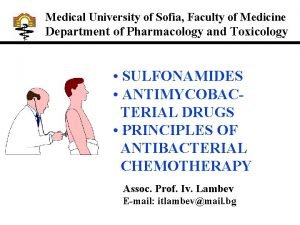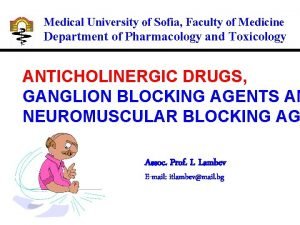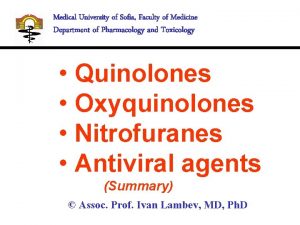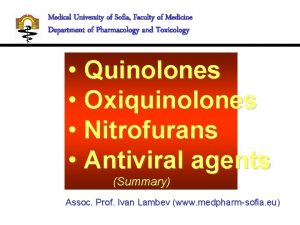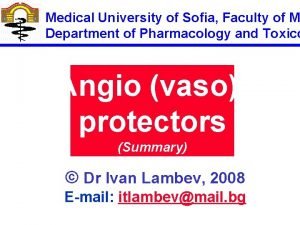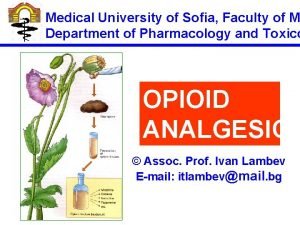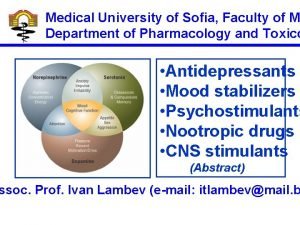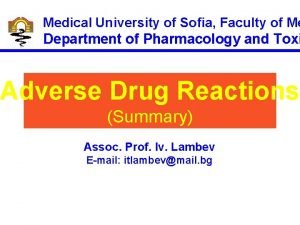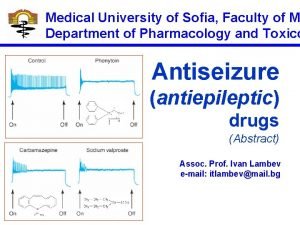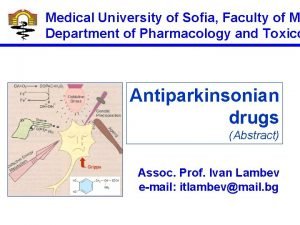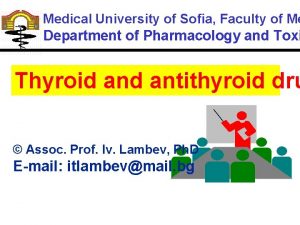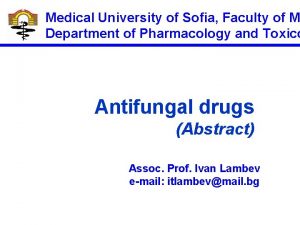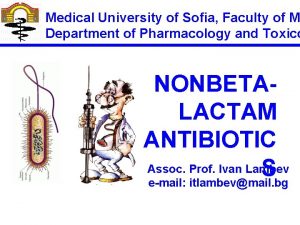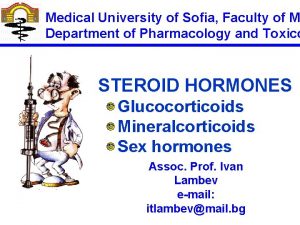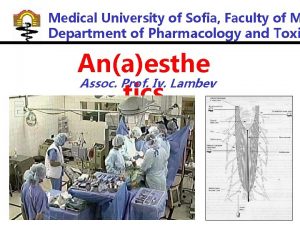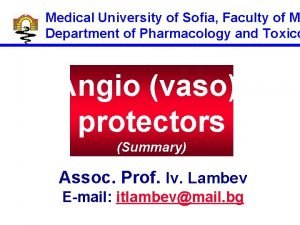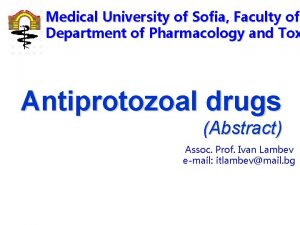Medical University of Sofia Faculty of Medicine Department





































































- Slides: 69

Medical University of Sofia, Faculty of Medicine Department of Pharmacology and Toxicology 1431 Sofia, 2 “Zdrave” Str. , Phone (02) 9172 -621 AUTOCOIDS (LOCAL HORMONES) AND THEIR PHARMACOLOGICAL MODULATION Assoc. Prof. Ivan Lambev E-mail: itlambev@mail. bg

THEY • play an important role in the physiological and pathological processes • very short t 1/2 • local action

1. Monoamines • Histamine • Serotonin (5 -HT)

Histamine 2 -(4 -imidazolyl)-ethylamine

Histamine is a basic amine. It is formed from amino acid histidine by histidine decarboxylase.

The synthesis and breakdown of histamine Essential of Medical Pharmacology – 5 st Ed. (2003)

• Histamine is presented in high concentration in the skin, and in the mucous layer of the lung and GIT as an autacoid. • At cellular level, it is found largely in mast cell and basophiles. • Non-mast-cell histamine occurs as a neurotransmitter in CNS.

In mast cells and basophiles histamine is held in intracellular granules together with heparin.

Histamine is released from mast cells by a secretory process during inflammatory or allergic reactions (Ag-Ab reactions). The secretory process is initiated by a raise in intracellular Ca 2+. Histamine is released from mast cells during burns too.

Some drugs (mainly alkaloids atropine, morphine, reserpine, tubocurarine) release histamine by non-receptor action and can cause bronchoconstriction, arterial hypotension and other unwanted effects.

Naja naja Folia Urticae (Leaves of Nettle)

Spoilt (putrid) fish contains histidine!

FISH ALLERGY

Agents which increase c. AMP (adrenaline, salbutamol and other beta-adrenoceptor agonists) inhibit histamine secretion and produce bronchodilation (antiasthmatic effect).

• Histamine produces effects by acting on H 1, H 2, H 3, H 4 and H 5 -receptors. • Histamine’s receptors are G-protein coupled.

Stimulation of H 1 -receptors • contraction of endothelium, increasing of vascular permeability and producing type I hypersensitivity reactions (urticaria and hay fever)

Histamine and antagonists of H 1 -receptors (H 1 -blockers)

H 1 -blockers • Use mainly for treatment of urticaria and hay fever. • Some of them (embramine, promethazine) have antiemetic effect.

H 1 -blockers from 1 st generation (with sedative and M-cholinolytic effects) promethazine dimetindene cyproheptadine embramine (H 1&5 -HT 2) chlorpyramine clemastine (weak sedation)

H 1 -blockers from nd 2 generation (without sedative and M-cholinolytic effects) astemizole cetirizine loratadine terfenadine prolongation of QT interval and hypokalemia

H 1 -blockers from nd 3 generation • Desloratadine (Aerius® – film-tab. 5 mg; t 1/2 27 h) • Levocitirizine

Stimulation of H 2 -receptors: • cardiac stimulation • stimulation of gastric acid secretion

Antagonist of H 2 -receptors (H 2 -blockers) - for treatment of peptic ulcer: • Cimetidine (? …) • famotidine • nizatidine • ranitidine • roxatidine

Mast cell stabilizers • prevent histamine release from mast cells • Are prescribed prophylactically in allergic asthma - cromoglycate - ketotifen - nedocromil

Rang et al. Pharmacology – 5 st Ed. (2003) Serotonin (5 -Hydroxytryptamine: 5 -HT) Indol derivative


Structures rich in 5 -HT • GIT (chromaffin cells and enteric neurons) • platelets • CNS

Important actions of 5 -HT • increased GI motility • increased platelet aggregation • increased microvascular permeability • stimulation of nociceptive nerve endings • control of appetite, sleep, mood, hallucinations, stereotyped behavior, pain perception and vomiting

Clinical conditions in which 5 -HT plays a role include: • migraine • mood disorders (depressive illnesses) • anxiety • vomiting • carcinoid syndrome (malignant tumors of enterochromaffin cells in intestines)

5 -HT 1 -receptors: • 5 -HT 1 A - 5 -HT 1 F • All subtypes occur in CNS and cause neural inhibition • Act by inhibiting adenylate cyclase

Buspirone • anxiolytic agent • partial agonist of the 5 -HT 1 A-receptors • used in anxiety

5 -HT 1 D-receptors are found in some blood vessels (a. carotis externa et interna, meningeal vessels). They produce vasoconstriction. pathophysiology of migraine

Rang et al. Pharmacology – 5 st Ed. (2003) Pathogenesis of migraine and drug treatment

The agonist of 5 -HT 1 D-receptors are highly effective, but expensive, in acute attacks of migraine: • Naratriptan • Rizatriptan • Sumatriptan • Zolmitriptan

Activation of 5 -HT 2 -receptors • in CNS produces excitement • in blood vessels - contraction and platelet aggregation • act through phospholypase C/ inositol phosphate pathway

Antagonists of 5 -HT 2 -receptors are used: • for prophylaxis of migraine - cyprohepatadine - iprazochrome - methysergide - pizotifen • as a peripheral vasodilator - Naftidrofuryl (Dusodril®)

Adverse effects of methysergide: • retroperitoneal fibrosis • renal failure

SSRIs (selective serotonin reuptake inhibitors) are used in: • chronic anxiety • depression • bulimia

SSRIs include • fluoxetine • fluvoxamine • paroxetine • sertraline etc.

5 -HT 3 -receptors • Located in enteric neurons and in CNS. • Act by stimulating adenylate cyclase. • Effects are excitatory, causing GI motility and vomiting.

Antagonists of 5 -HT 3 receptors are very powerful antiemetics: dolasetron granisetron ondansetron tropisetron

Agonists of 5 -HT 4 -receptors • Tegaserod (Zelmac®) activates 5 -HT 4 receptors in the intestine and stimulates peristalsis and secretion. Indication: colon irritable syndrome

(eicosi = 20) 2. EICOSANOIDS (20 carbon atoms!) • prostanoids - prostaglandins (PGs) - thromboxanes (Txs) • leucotrienes (LTs) • lipoxins

• The eicоsanoids are important mediators of inflammation and allergy. • The main source of eicosanoids is arachidonic acid. It is a 20 -carbon unsaturated fatty acid.

IL® Inflammatory stimulus Phospholipids Phospholipase A 2 Arachidonic acid 5 -lipoxygenase Cyclooxygenase (Cox) 15 -lipoxygenase Leucotrienes Lipoxins Endoperoxides PGs Tx. A 2

PROSTANOIDS (PGs & Txs) PGI 2 (prostacyclin) is located predominantly in vascular endothelium. Main effects: • vasodilatation • inhibition of platelet aggregation Tx. A 2 is found in the platelets. Main effects: • platelet aggregation • vasoconstriction

PGE 1 • alprostadil (prodrug – used to maintain the patency of the ductus arteriosus in neonates with congenital heart defects, and for treatment of erectile dysfunction by injection into the corpus cavernosum of the penis); • misoprostol (used for prophylaxis of peptic ulcer associated with NSAIDs); • gemeprost used as pessaries to soften the uterine cervix and dilate the cervical canal prior to vacuum aspiration for termination of pregnancy.

PGE 2 causes: • contraction of pregnant uterus • inhibition of gastric acid secretion • contraction of GI smooth muscles PGF 2α – main effects: • contraction of bronchi • contraction of miometrium

Dorland’s Illustrated Medical Dictionary (2003, 2004) PGE 1 (gemeprost) PGF 2α (dinoprost) PGE 2 (dinoprostone) are given for: • induction of labour • termination of pregnancy

Main actions of the eicosanoids Lüllmann, Color Atlas of Pharmacology – 2 nd Ed. (2000)

Cyclooxygenase (COX) is found bound to the endoplasmatic reticulum. COX exists in 3 isoforms: • COX-1 (constitutive) acts in physiological conditions. • COX-2 (inducible) is induced in inflammatory cells by pathological stimulus. • COX-3 (in brain)


This has relevance for the mechanism of action of NSAIDs. The most of them inhibit mainly COX-1 and can cause peptic ulcer, GI bleeding, bronchial asthma, and nephrotoxicity.

Inhibiting activity rate (COX-2/COX-1) • Aspirin • Indometacin • Meloxicam 155 60 0, 8 T U O F O A D E T

Arachidonic acid Cyclooxygenase (Cox) (-) >1 g/24 h Aspirin Endoperoxides (-) 100 mg/24 h Thromboxan A 2 synthase PGs Tx. A 2

Inflammatory stimulus (+) Phospholipase A 2 Phospholipids (-) Lipocortin Arachidonic acid (+) Glucocorticoids

INFLAMMATION • alteration NSAIDs (-) • exudation • proliferation (-) Gluco- corticoids (-)

3. Platelet activating Factor (PAF) • PLA 2 releases PAF in inflammation • PAF causes vasodilatation, increases vascular permeability, activates platelet aggregation

4. Non – hormonal peptides Opioid peptides • dynorphin (μ, δ, κ) • enkephalin (μ, δ) • endorphin (μ, δ, κ) • nociceptin – ORL 1 (tolerance)

ANALGESIA μ – on supraspinal level κ – on spinal level δ – mainly on peripheral level NB: Metamizole (Analgin®) stimulates the secretion of beta-endorphin (Vlaskovska M, Surcheva Sl, Ovcharov R, 1989).

Endothelins – strong long – acting vasoconstrictors ЕТ-1, ET-2 и Е-3 ЕТА-receptors: >>> vasoconstriction ЕТB-receptors: 30 s vasodilatation ET-1 plasma levels increase in vascular spasm and acute myocardial infarction.

Angiotensin II AT 1 - receptor • Vasoconstriction • Proliferative effects AT 2 - receptors • Vasodilation • Antiproliferative effects Secretion of aldosterone

(-) Renin synthesi s Angiotensin I Chimas e 80% Catepsin G Angiotensinogen ACE (-) Sartans (-) AT 1 - receptor AT 2 - receptor Kinins Angiotensin II Beta – blockers ACE inhibitors (-) ACE (kininase II) Degradation IL®

Cytokines Regulatory peptides of inflammation and allergic reactions

Cytokines act together (“as a team”) on: endothelium, leucocytes, mastocytes, fibroblasts, stem cells and osteoclasts. Cytokines control their proliferation, differentiation and/or activation by receptor mechanism.

IL-1 participates in pathogenesis of rheumatoid arthritis. Glucocorticosteroids and glucosamine depress the synthesis of IL– 1. IL-2 (Aldesleukin) – i. v. in renal Ca. IL-11 stimulates thrombocytopoesis

• Interferon alpha-2 b © (Intron ): - in chronic hepatitis B and C - lymphomas, melanomas etc. • Interferon beta-1 b © (Betaferon ) s. c. in multiple sclerosis • Inerferon gamma – in the regulation of the immune system

• Colony-stimulating factors (r. Hu. CSFs): - Filgrastim, Molgramustim • Erythropoetin: - Epoetin alpha et beta • TNF-alpha; TNF-beta

 Hubert kairuki memorial university faculty of medicine
Hubert kairuki memorial university faculty of medicine Solid thyroid nodule
Solid thyroid nodule Applied medical sciences
Applied medical sciences Semmelweis university faculty of medicine
Semmelweis university faculty of medicine Faculty of veterinary medicine cairo university logo
Faculty of veterinary medicine cairo university logo Hacettepe university faculty of medicine
Hacettepe university faculty of medicine Faculty of veterinary medicine - university of tehran
Faculty of veterinary medicine - university of tehran Semmelweis university faculty of medicine
Semmelweis university faculty of medicine Faculty of veterinary medicine cairo university
Faculty of veterinary medicine cairo university Cairo university faculty of veterinary medicine
Cairo university faculty of veterinary medicine Masaryk university medical faculty
Masaryk university medical faculty Masaryk university medical faculty
Masaryk university medical faculty Mrbs scholarship
Mrbs scholarship Department of medicine mcgill
Department of medicine mcgill Pubh4401
Pubh4401 Emory clinic - school of medicine faculty
Emory clinic - school of medicine faculty Keralastec
Keralastec Elearn st kliment
Elearn st kliment University of chemical technology and metallurgy
University of chemical technology and metallurgy Technical university sofia
Technical university sofia Technical university of sofia
Technical university of sofia Medical faculty in novi sad dean
Medical faculty in novi sad dean Herszon kherson maritime college of merchant marine fleet
Herszon kherson maritime college of merchant marine fleet Bridgeport engineering department
Bridgeport engineering department University of bridgeport computer science faculty
University of bridgeport computer science faculty Florida state university masters in computer science
Florida state university masters in computer science Faculty of business and economics mendel university in brno
Faculty of business and economics mendel university in brno Singularity executive program
Singularity executive program Feup university of porto
Feup university of porto Webkredit cuni
Webkredit cuni Faculty of law of the university of zagreb
Faculty of law of the university of zagreb University of montenegro faculty of law
University of montenegro faculty of law University of kragujevac faculty of technical sciences
University of kragujevac faculty of technical sciences University of cologne faculty of management
University of cologne faculty of management Leading university founder
Leading university founder Brown university computer science faculty
Brown university computer science faculty Lebanese university roumieh
Lebanese university roumieh Concurrent education york
Concurrent education york Elearningunideb
Elearningunideb Clemson university electrical engineering
Clemson university electrical engineering Faculty of mechanical engineering thammasat university
Faculty of mechanical engineering thammasat university Faculty of business and economics mendel university in brno
Faculty of business and economics mendel university in brno Faculty of public health mahidol university
Faculty of public health mahidol university University of pecs faculty of health sciences
University of pecs faculty of health sciences Faculty of education khon kaen university
Faculty of education khon kaen university Shawhong ser
Shawhong ser Department of medicine solna
Department of medicine solna Meritus family medicine
Meritus family medicine University of medicine and pharmacy timisoara
University of medicine and pharmacy timisoara Lincoln memorial university college of veterinary medicine
Lincoln memorial university college of veterinary medicine King faisal university college of medicine
King faisal university college of medicine King saud university college of medicine
King saud university college of medicine King saud university college of medicine
King saud university college of medicine University of wisconsin integrative medicine anxiety
University of wisconsin integrative medicine anxiety Victor babeş university of medicine and pharmacy
Victor babeş university of medicine and pharmacy Victor babes university of medicine and pharmacy
Victor babes university of medicine and pharmacy King saud university college of medicine
King saud university college of medicine Brno veterinary
Brno veterinary Slu family medicine residency
Slu family medicine residency Al mustansiriya university college of medicine
Al mustansiriya university college of medicine Midwestern university college of dental medicine
Midwestern university college of dental medicine Seoul national university medical school
Seoul national university medical school Ukcom curriculum
Ukcom curriculum Unm emergency medicine residents
Unm emergency medicine residents Teala
Teala University of arizona emergency medicine
University of arizona emergency medicine Tracer card medical record
Tracer card medical record Medical education and drugs department
Medical education and drugs department Department of law university of jammu
Department of law university of jammu Department of geology university of dhaka
Department of geology university of dhaka











